The Characteristics of Fracturing Fluid Distribution after Fracturing and Shut-In Time Optimization in Unconventional Reservoirs Using NMR
Abstract
:1. Introduction
2. Experimental
2.1. Materials and Equipment
2.2. Experimental Steps
- (1)
- A wire cutting machine was used to cut the core to the required size for the thin section experiment (the thickness of the core thin section was 1~2 mm). A polishing sander was then used to make the thin section smooth, and the core thin section was washed. The cleaned core was placed in a constant temperature box set at 70 °C until the weight of the thin section no longer changed, indicating that it had reached a stable dry weight. The diameter, thickness, mass, permeability, and other basic parameters of the thin section were measured, and full-field and local field photos were taken of the dry sample with a stereomicroscope. Then, the dried core thin section was pressurized and saturated with simulated formation water for 24 h until the wet weight of the core no longer changed, resulting in a core thin section saturated with water.
- (2)
- The saturated core thin section was scanned and imaged with nuclear magnetic resonance to obtain the T2 spectrum and imaging image of the saturated water. The scanned core was placed in a constant temperature box at 70 °C for drying. Then, the core thin section was placed in a prepared 40% manganese chloride solution for saturation. The core thin section saturated with a 40% manganese chloride solution was scanned and imaged with a nuclear magnetic resonance analyzer to obtain the T2 spectrum and imaging image of the saturated manganese. It was then photographed with a stereomicroscope in both full and local fields.
- (3)
- The core thin section was placed in a displacement device to start oil displacement until water no longer came out of the outlet, forming a core saturated with oil with a certain bound water saturation. The core thin section was scanned and imaged with a nuclear magnetic resonance analyzer to obtain the T2 spectrum and imaging image.
- (4)
- The original oil-containing core thin section with bound water was placed in the displacement device and displaced with a 40% manganese chloride solution until no oil was produced from the outlet. The core thin section was scanned and imaged with a nuclear magnetic resonance analyzer and then photographed with a stereomicroscope.
- (5)
- The core thin section, after water flooding the oil, was reversed with oil until water no longer came out of the outlet. The core thin section was scanned and imaged with a nuclear magnetic resonance analyzer and then photographed with a stereomicroscope. This was done to prepare samples for the spontaneous imbibition displacement oil experiment.
- (6)
- The core thin sections were placed in a 40% manganese chloride solution to simulate the shut-in process. The core thin sections were removed after being shut-in for 3 days, 5 days, 7 days, and 10 days to monitor the distribution of fracturing fluid and the situation of imbibition displacement oil.
3. Results and Discussion
3.1. Characteristics of the Fracturing Fluid Distribution during the Shut-In Period
3.2. Optimization of the Shut-In Time Method Post-Fracture
4. Conclusions
- (1)
- Filtrate retention occurred in pore throats with radii ranging from 0.0012 μm to 0.025 μm. During the shut-in process, pore throats with radii ranging from 0.003 μm to 0.07 μm were the power pore throats in soaking displacement and were the main sites where filtrate retention occurred in the Chang 7 tight oil reservoir.
- (2)
- After shut-in, the retention amount of pressure fluid filtrate increased to a certain extent compared to before shut-in. When the shut-in time in the Chang 7 reservoir was 7 days, the growth rate of fracturing fluid filtrate retention was the highest. When shut-in occurred for 10 days, no oil was expelled from medium and large pores, and the amount of filtrate retained was lower than when shut-in occurred for 7 days. The reasonable shut-in time should be 7 days.
- (3)
- By combining low-field nuclear magnetic resonance, an experimental method was proposed to characterize the distribution of fracturing fluid during the shut-in time post-fracture in unconventional reservoirs. This method helped reveal the distribution characteristics of retained fracturing fluid in different pore sizes, providing theoretical and technical support for the development of tight oil reservoirs.
Author Contributions
Funding
Data Availability Statement
Conflicts of Interest
References
- Cao, J.; Yang, Y. The present situation and prospect of enhancing low permeability reservoir recovery technology in china. Sichuan Chem. Ind. 2017, 20, 17–21. [Google Scholar]
- Zou, C.; Yang, Z.; Zhu, R.; Zhang, G.; Hou, L.; Wu, S.; Tao, S.; Yuan, X.; Dong, D.; Wang, Y.; et al. Progress in china’s unconventional oil & gas exploration and development and theoretical technologies. Acta Geol. Sin. 2015, 89, 979–1007. [Google Scholar]
- Sun, L.; Zou, C.; Jia, A.; Wei, Y.; Zhu, R.; Wu, S.; Guo, Z. Development characteristics and orientation of tight oil and gas in China. Pet. Explor. Dev. 2019, 46, 1015–1026. [Google Scholar] [CrossRef]
- Xie, Y.; Liu, X.; Wang, J.; Wu, N.; Hu, C.; Wang, Y. Characteristics and main controlling factors of tight oil reservoirs in Chang 7 Member of Yanchang Formation inOrdos Basin, North Shaanxi. Mar. Geol. Quat. Geol. 2022, 42, 149–159. [Google Scholar]
- Zhang, D.; Zhang, L.; Tang, H.; Zhao, Y. Fully coupled fluid-solid productivity numerical simulation of multistage fractured horizontal well in tight oil reservoirs. Pet. Explor. Dev. 2022, 49, 338–347. [Google Scholar] [CrossRef]
- Li, S.; Xia, Y.; Lan, J.; Ye, S.; Ma, X.; Zou, J.; Li, M. CO2 flooding experiment in the Chang-7 tight oil reservoir of Ordos Basin. Sci. Technol. Eng. 2020, 20, 2251–2257. [Google Scholar]
- Wang, H.; Zhao, W.; He, H.; Feng, J. Characteristics oftight oil reservoirs in ordos basin--a case study of Chang-7 memberof longdong area. Ordos Basin. Unconv. Oil Gas 2019, 6, 42–51. [Google Scholar]
- Zhao, J.; Fan, J.; Xue, T.; Wu, D.; Wang, C. Classification and evaluation of Chang 7 tight oil reservoirseepage features in Ordos Basin. J. Northwest Univ. (Nat. Sci. Ed.) 2018, 48, 857–866. [Google Scholar]
- Zhou, X.; He, S.; Liu, P. Characteristics and classi-fication of tight oil pore structure in reservoir Chang 6 of Daijiapingarea, Ordos Basin. Earth Sci. Front. 2016, 23, 253–265. [Google Scholar]
- Wang, X.Z.; Zhao, X.S.; Dang, H.L.; Xiao, Q.H.; Qi, Z.L. Characteristics of movable fluids for chang 7 tight reservoir in Yanchang oilfield. Sci. Technol. Eng. 2018, 18, 72–77. [Google Scholar]
- Zhongxing, L.; Jian, L.; Xuefeng, Q.; Xianwen, L.; Qihong, L.; Jianming, F. The experiment and rec-ognition of the development of Chang 7 tight oil in Ordos Basin. Nat. Gas Geosci. 2015, 26, 1932–1940. [Google Scholar]
- Han, W.X.; Hou, L.H.; Yao, J.L.; Ma, W.J. Characteristics andformation mechanism of Chang 7 tight sandstone reservoir in Ordos Basin. J. China Univ. Min. Technol. 2016, 45, 765–771. [Google Scholar]
- Zhang, Y.; Ge, H.; Zhao, K.; Liu, S.; Zhou, D. Simulation of pressure response resulted from non-uniform fracture network communication and its application to interwell-fracturing interference in shale oil reservoirs. Geomech. Geophys. Geo-Energy Geo-Resour. 2022, 8, 114. [Google Scholar] [CrossRef]
- Zhang, Y.; Zou, Y.; Zhang, Y.; Wang, L.; Liu, D.; Sun, J.; Ge, H.; Zhou, D. Experimental Study on Characteristics and Mechanisms of Matrix Pressure Transmission Near the Fracture Surface During Post-Fracturing Shut-In in Tight Oil Reservoirs. J. Pet. Sci. Eng. 2022, 219, 111133. [Google Scholar] [CrossRef]
- Li, X.; Zhao, Z.; Li, Z.; Wang, C.; Cong, H. Stochastic fractal modal for fracture network parameter inversion of fracturing horizontal well. Fault-Block Oil Gas Field 2019, 26, 205–209. [Google Scholar]
- Xie, B.; Jiang, J.; Jia, J.; Ren, L.; Huang, B.; Huang, X. Partition seepage model and productivity analysis of fractured borizontal wells of tight reservoirs. Fault-Block Oil Gas Field 2019, 26, 324–328. [Google Scholar]
- Talechani, A.D.; Olson, J.E. Numerical modeling of multistranded hydraulic-fracture propagation accounting for the interaction between induced and natural fractures. SPE J. 2011, 16, 575–581. [Google Scholar] [CrossRef]
- Jin, X.; Shah, S. Fracture propagation direction and its application in hydraulic fracturing. SPE J. 2013, 18, 608–620. [Google Scholar]
- Cipolla, C.; Weng, X.; Mack, M.; Ganguly, U.; Gu, H.; Kresse, O.; Cohen, C. Integrating microseismic mapping and complex fracture modeling to characterrize fracture complexity. SPE J. 2011, 16, 368–380. [Google Scholar]
- Parmar, J.; Dehghanpour, H.; Kuru, E. Displacement of water by gas in propped fractures: Combined effects of gravity, surface tension, and wettability. J. Unconv. Oil Gas Resour. 2014, 5, 10–21. [Google Scholar] [CrossRef]
- Liu, Y. Modeling of Recovery and In-Situ Distribution of Fracturing Fluid in Shale Gas Reservoirs due to Fracture Closure, Proppant Distribution and Gravity Segregation. Master’s Thesis, University of Alberta, Edmonton, AB, Canada, 2017. [Google Scholar]
- Le, D.H.; Hoang, H.N.; Mahadevan, J. Impact of capillary section on fracture face skin evolution in water blocked wells. In Proceedings of the SPE Hydraulic Fracturing Technology Conference, The Woodlands, TX, USA, 31 January–2 February 2023; Society of Petroleum Engineers: Richardson, TX, USA, 2023. [Google Scholar]
- Baharmi, H.; Rezaee, R.; Clennel, B. Water blocking damage in hydraulically fractured tight sand gas reservoirs: An example from Perth Basin, Western Australia. J. Pet. Sci. Eng. 2012, 88, 100–106. [Google Scholar] [CrossRef]
- Tang, J.; Wu, K.; Li, Y.; Hu, X.; Liu, Q.; Ehlig-Economides, C. Numerical investigation of the interactions between hydraulic fracture and bedding planes with non-orthogonal approach angle. Eng. Fract. Mech. 2018, 200, 1–16. [Google Scholar] [CrossRef]
- Kamath, J.; Laroche, C. Laboratory-Based Evaluation of Gas Well Deliverability Loss Caused by Water Blocking. Soc. Pet. Eng. 2003, 8, 71–80. [Google Scholar] [CrossRef]
- Bostrom, N.; Chertov, M.; Pagels, M.; Willberg, D.; Chertova, A.; Davis, M.; Zagorski, W. The Time-Dependent Permeability Damage Caused by Fracture Fluid. Soc. Pet. Eng. 2014. [Google Scholar] [CrossRef]
- Wang, J.; Rahman, S.S. An Investigation of Fluid Leak-off Due to Osmotic and Capillary Effects and Its Impact on Micro-Fracture Generation during Hydraulic Fracturing Stimulation of Gas Shale. Soc. Pet. Eng. 2015. [Google Scholar] [CrossRef]
- Dutta, R.; Lee, C.-H.; Odumabo, S.; Ye, P.; Walker, S.C.; Karpyn, Z.T.; Ayala, H.L.F. Experimental Investigation of Fracturing-Fluid Migration Caused by Spontaneous Imbibition in Fractured Low-Permeability Sands. Soc. Pet. Eng. 2014. [Google Scholar] [CrossRef]
- Meng, M.; Ge, H.; Ji, W.; Shen, Y.; Su, S. Monitor the process of shale spontaneous imbibition in co-current and counter-current displacing gas by using low field nuclear magnetic resonance method. J. Nat. Gas Sci. Eng. 2015, 27, 336–345. [Google Scholar] [CrossRef]
- Yan, Q.; Lemanski, C.; Karpyn, Z.T.; Ayala, L.F. Experimental investigation of shale gas production impairment due to fracturing fluid migration during shut-in time. J. Nat. Gas Sci. Eng. 2015, 24, 99–105. [Google Scholar] [CrossRef]
- Odumabo, S.M.; Karpyn, Z.T.; Ayala, H.L.F. Investigation of gas flow hindrance due to fracturing fluid leak off in low permeability sandstones. J. Nat. Gas Sci. Eng. 2014, 17, 1–12. [Google Scholar] [CrossRef]
- Fakcharoenphol, P.; Kurtoglu, B.; Kazemi, H.; Charoenwongsa, S.; Wu, Y.-S. The Effect of Osmotic Pressure on Improve Oil Recovery from Fractured Shale Formations. Soc. Pet. Eng. 2014. [Google Scholar] [CrossRef] [Green Version]
- Wang, Q.; Guo, B.; Gao, D. Is Formation Damage an Issue in Shale Gas Development? Soc. Pet. Eng. 2012. [Google Scholar] [CrossRef]
- Li, J.; Yu, W.; Guerra, D.; Wu, K.V. Modeling wettability alteration effect on well performance in Permian basin with complex fracture networks. Fuel 2018, 224, 740–751. [Google Scholar] [CrossRef]
- Feng, X.; Jiang, H.; Li, W.; Fang, W.; Zhao, L. Study on formation damage of fracturing fluid to low-permeable reservoir by NMR. Complex Hydrocarb. Reserv. 2015, 8, 75–79. [Google Scholar]
- Zhang, Y.; Ge, H.; Shen, Y.; Jia, L.; Wang, J. Evaluating the potential for oil recovery by imbibition and time-delay effect in tight reservoirs during shut-in. J. Pet. Sci. Eng. 2019, 184, 106557. [Google Scholar] [CrossRef]
- Li, J.; Yu, W.; Wu, K. Analyzing the impact of fracture complexity on well performance and wettability alteration in Eagle Ford shale. In Proceedings of the SPE Unconventional Resources Technology Conference (URTeC), Houston, TX, USA, 23–25 July 2018. [Google Scholar] [CrossRef]



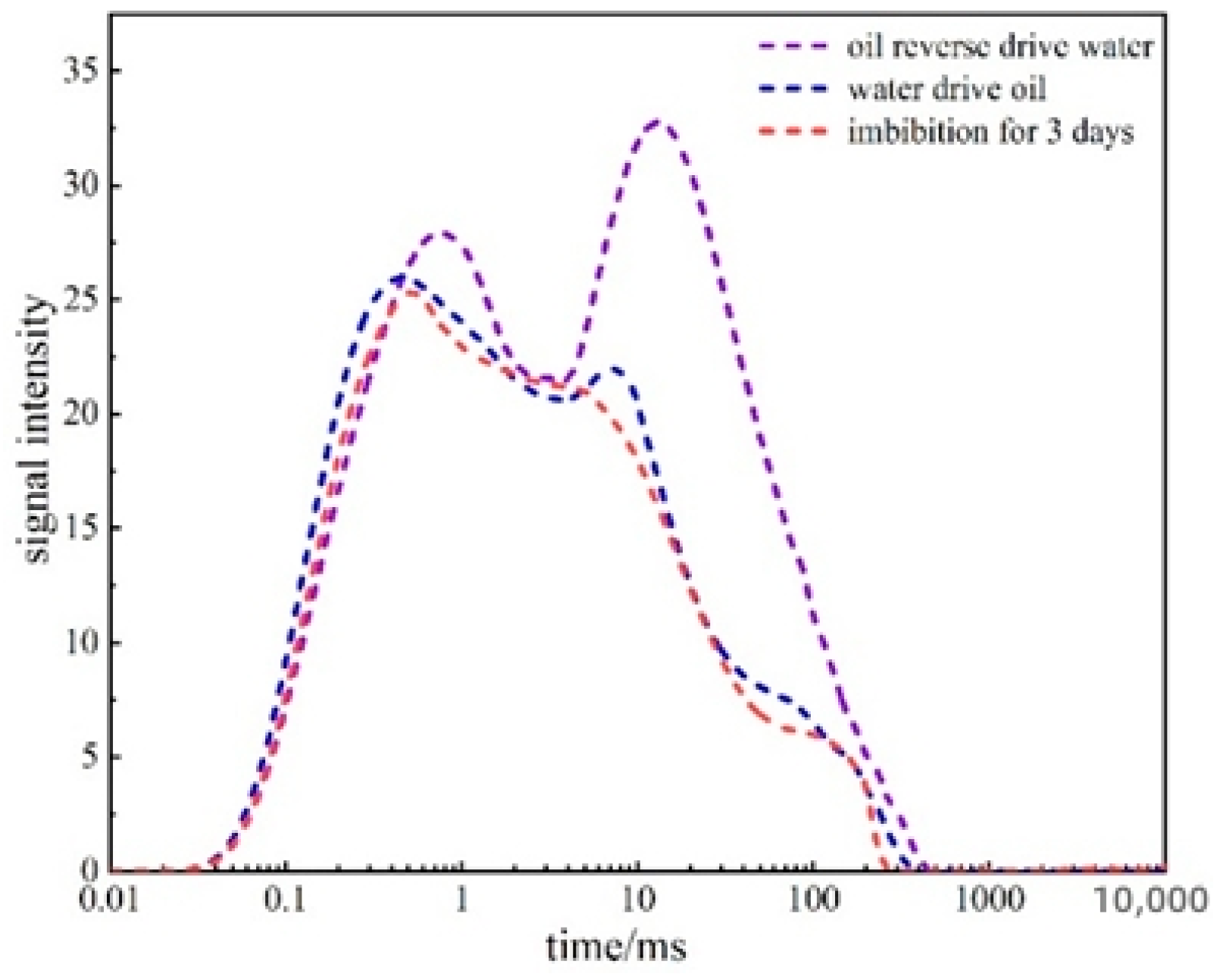


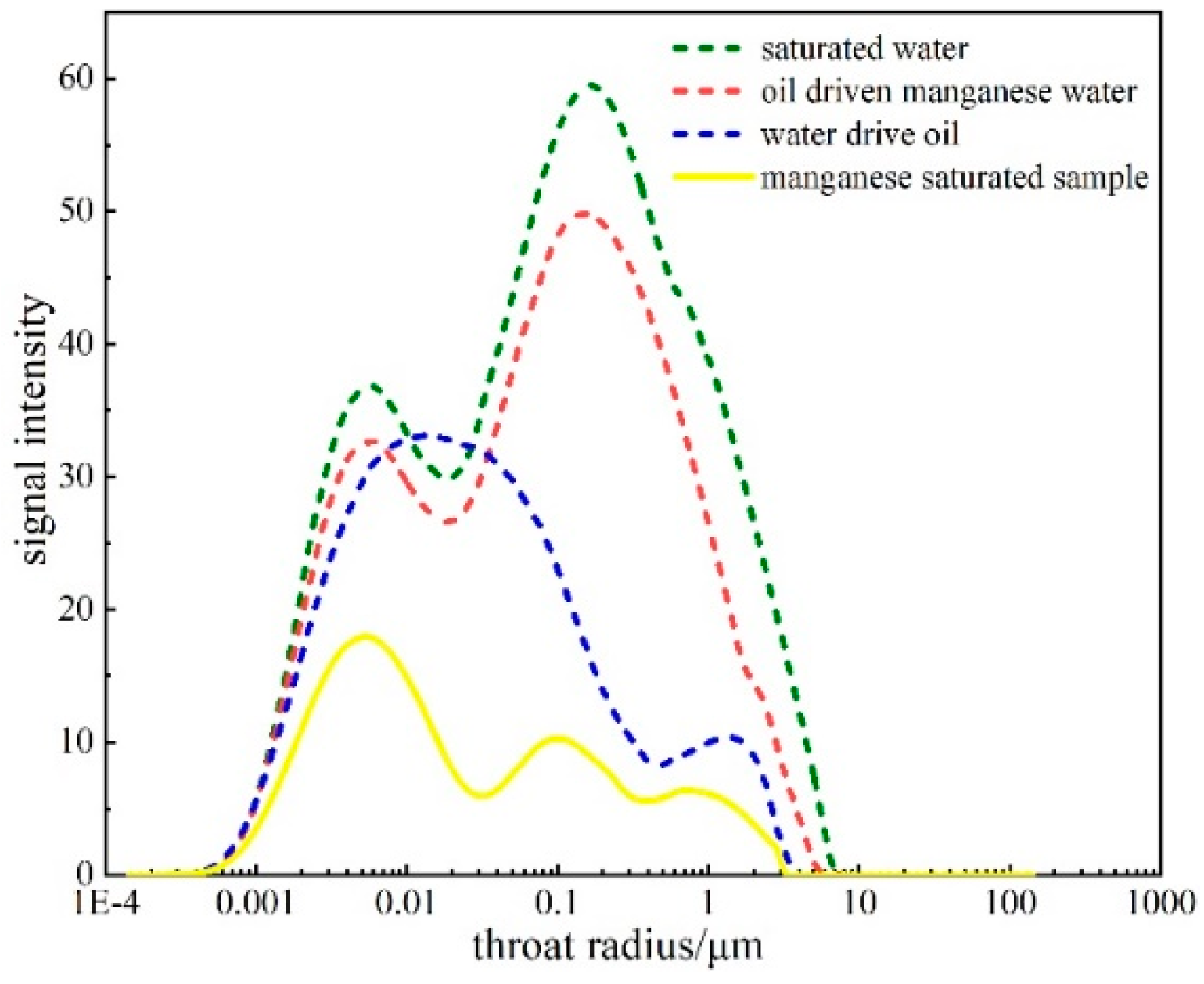


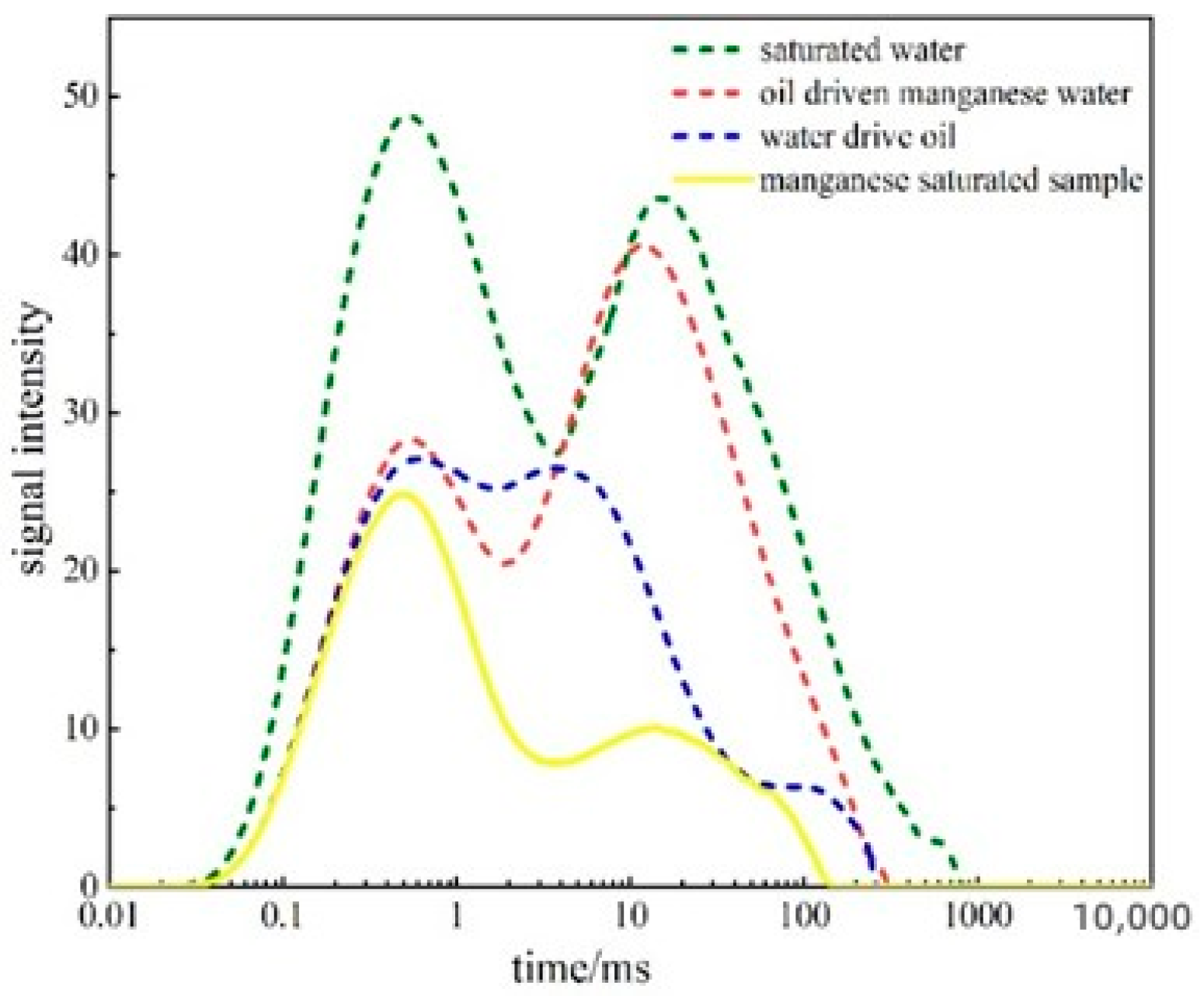
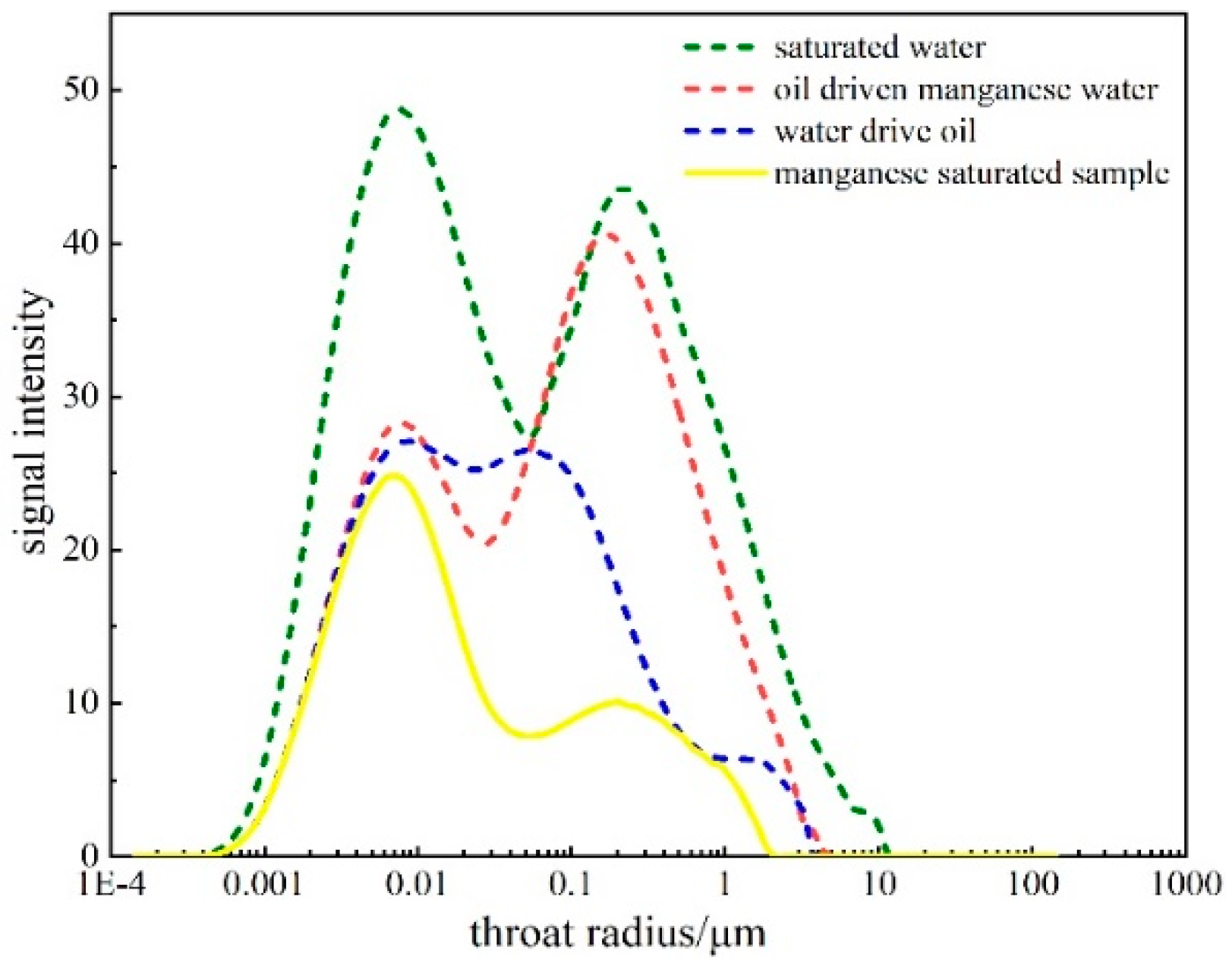


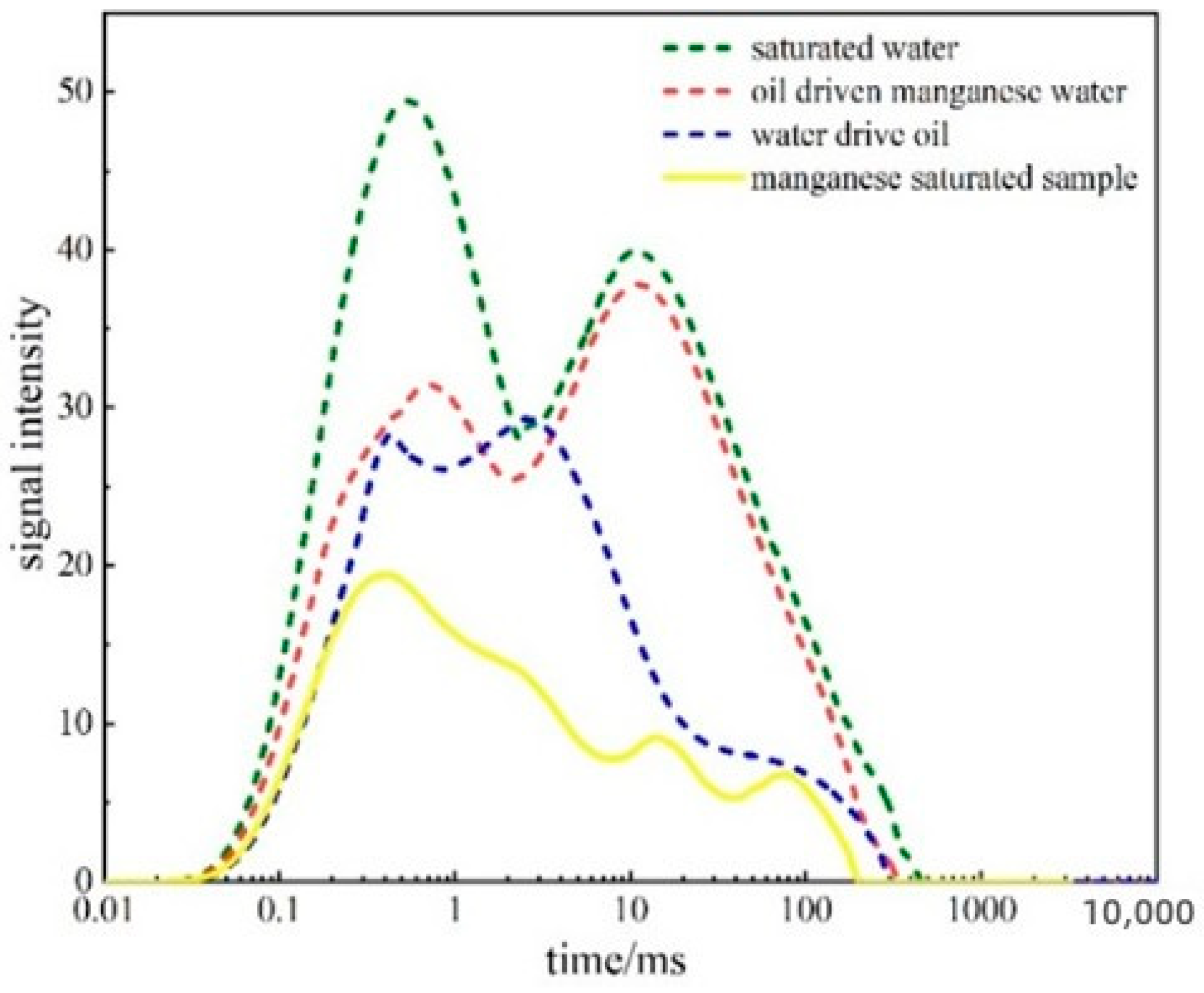
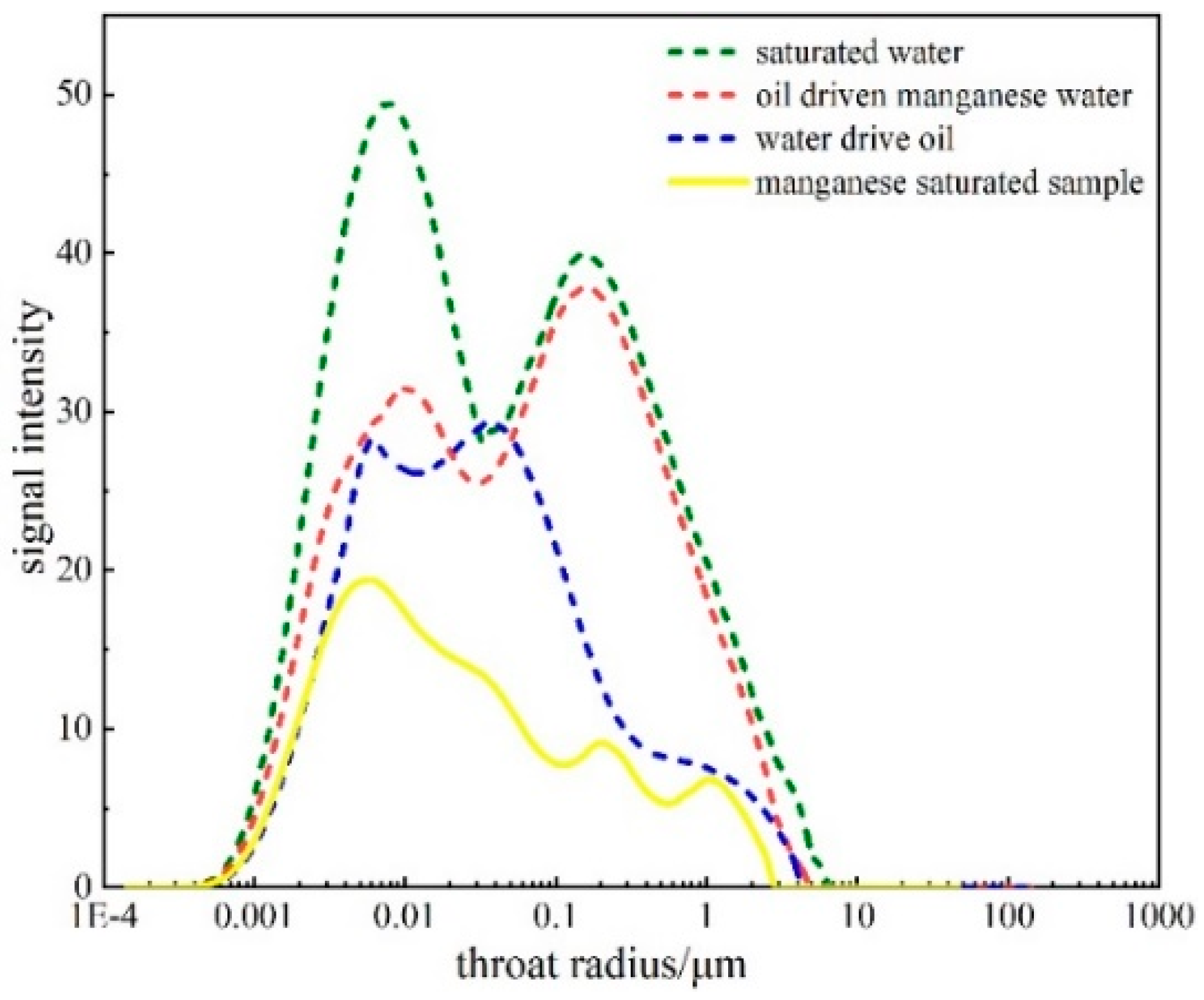

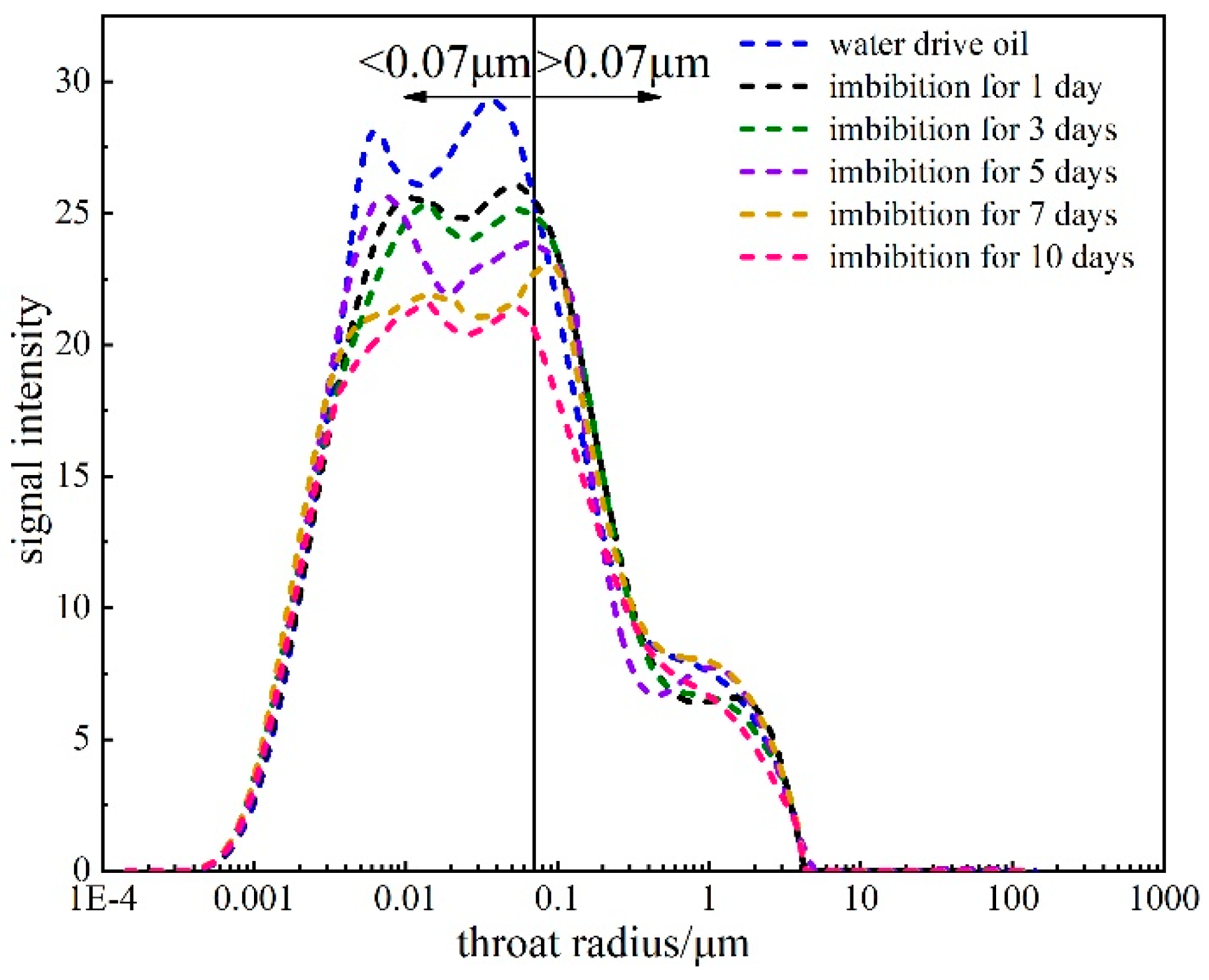

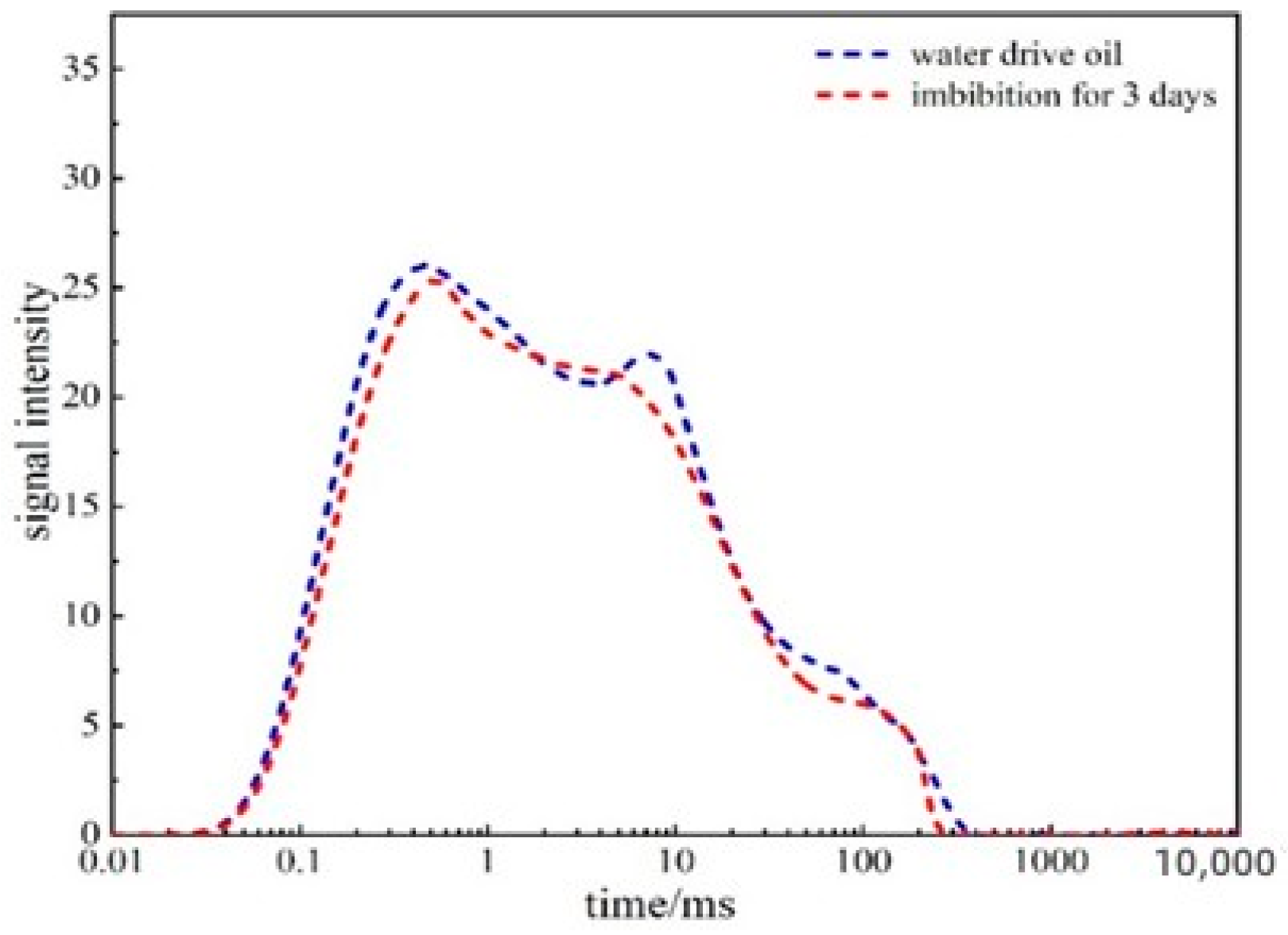
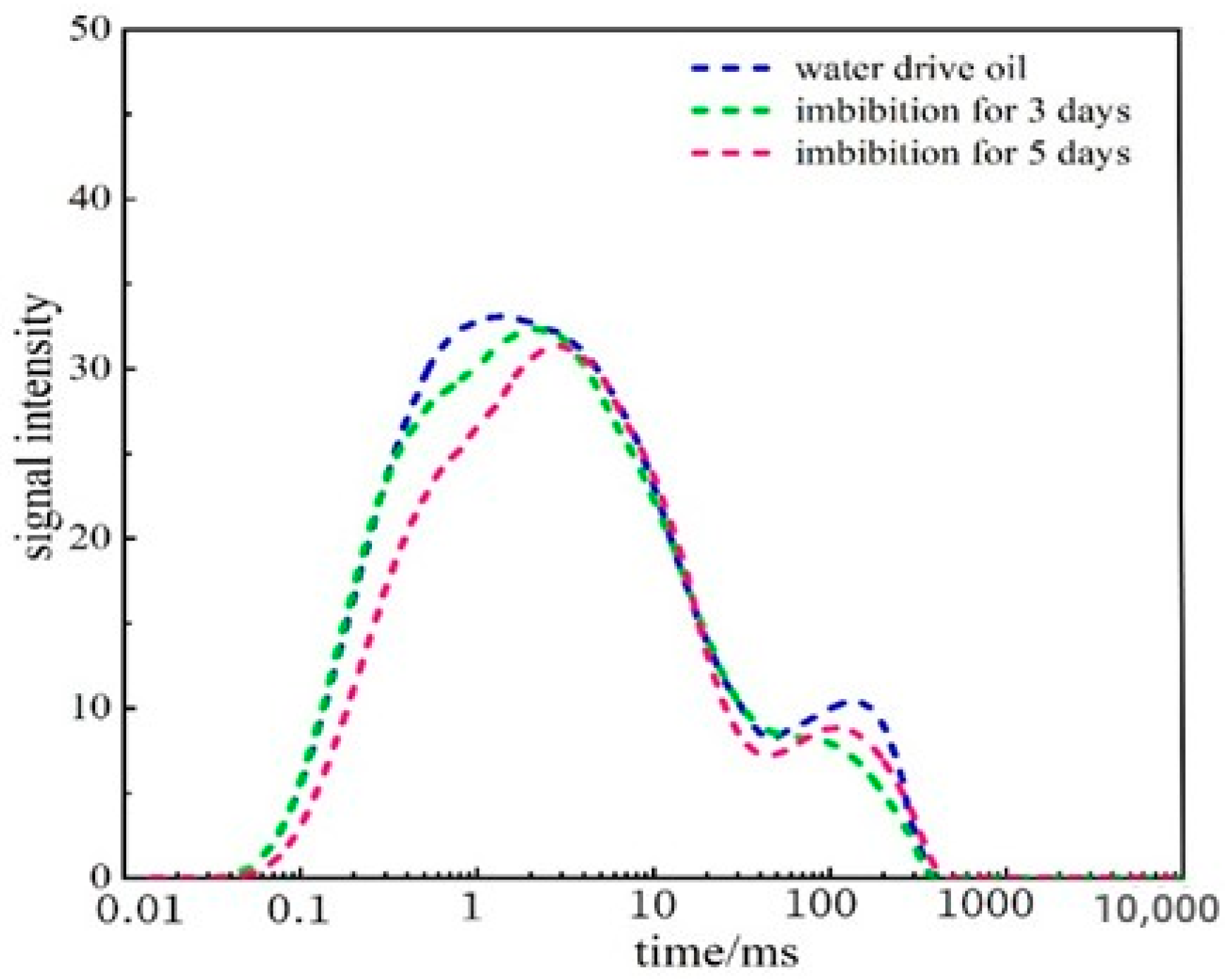
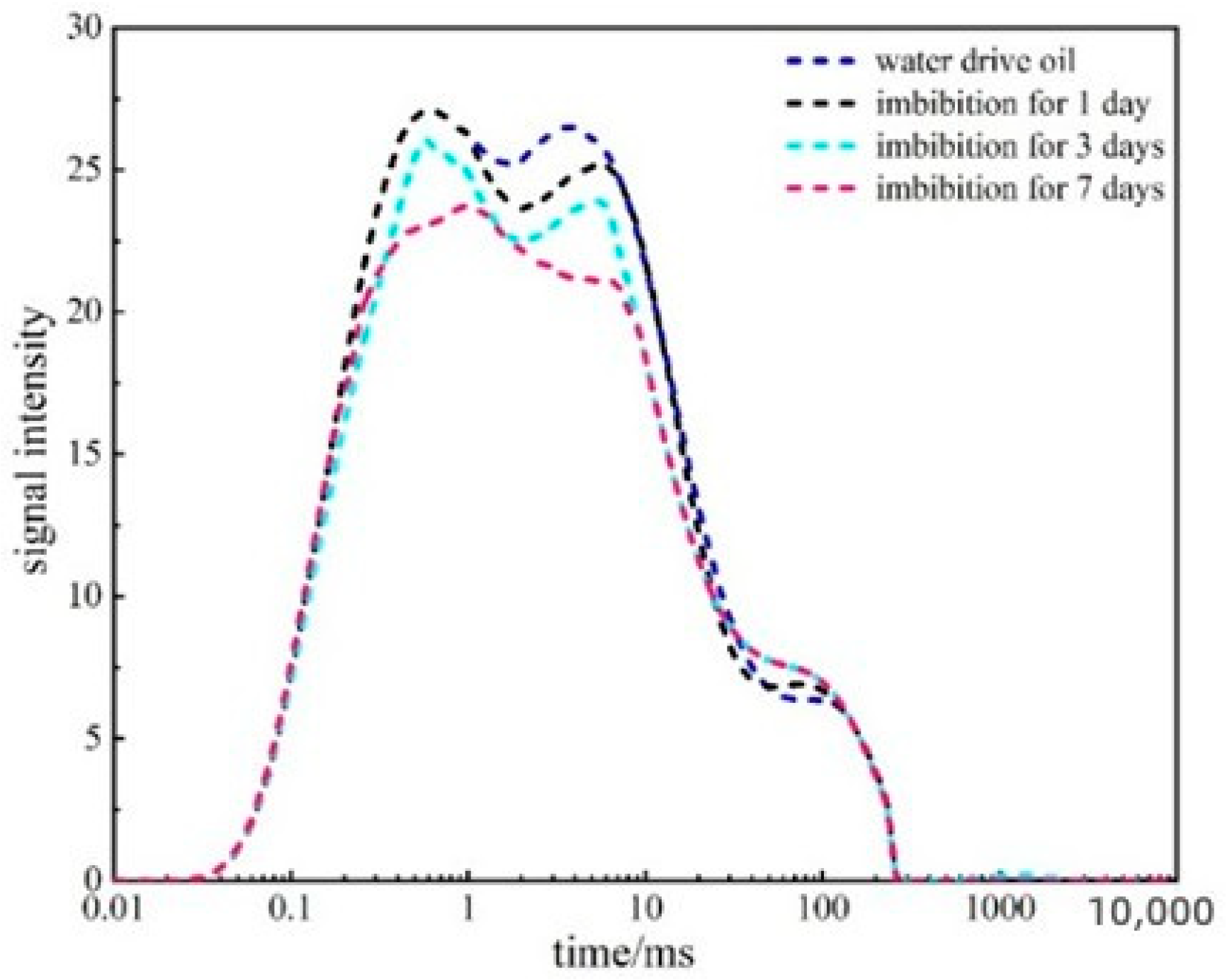

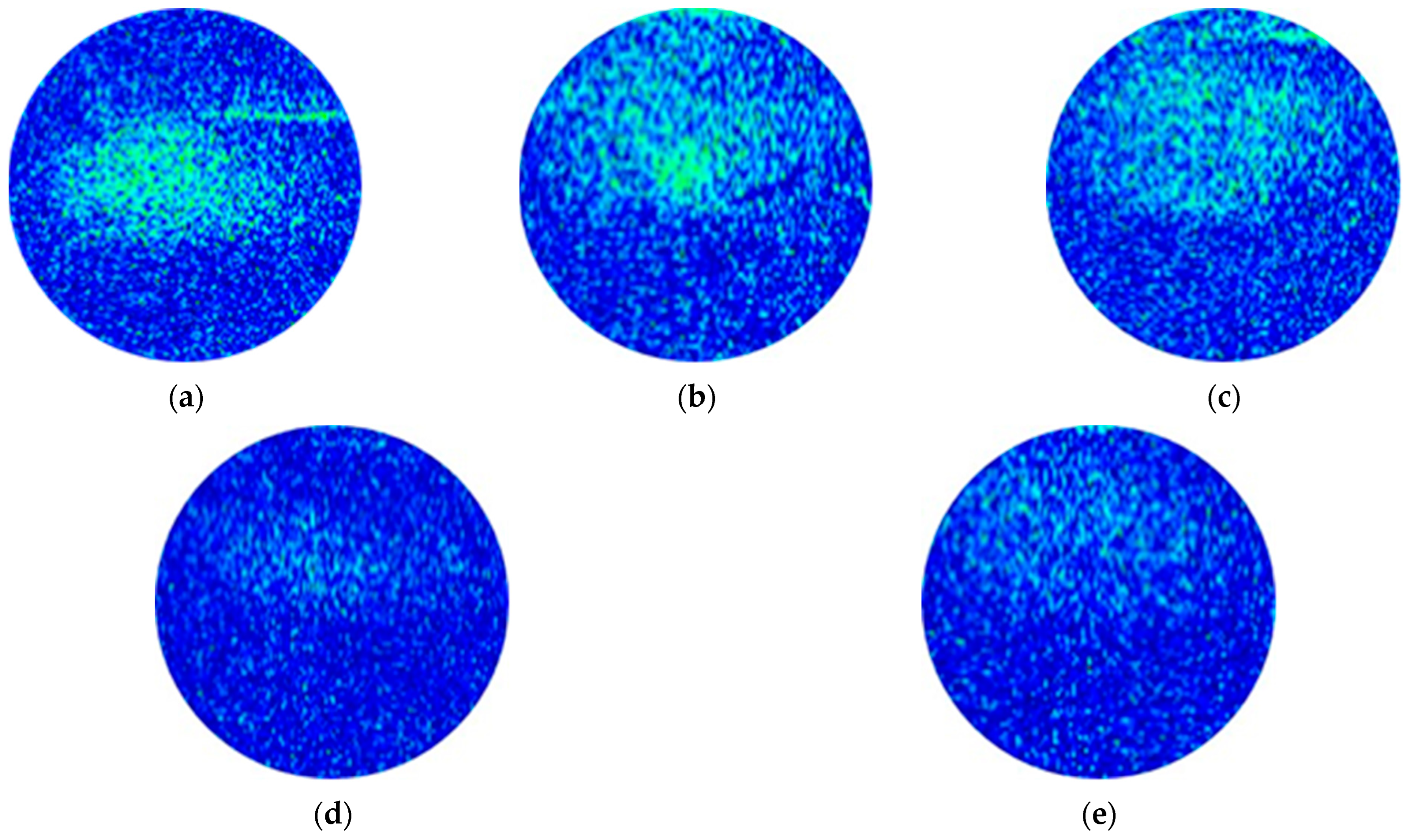
| Number | Diameter/mm | Thickness/mm | Weight/g | Permeability/mD |
|---|---|---|---|---|
| A-1 | 25.33 | 1.97 | 1.887 | 0.091 |
| A-2 | 25.33 | 2.53 | 2.664 | 0.034 |
| A-3 | 25.34 | 2.18 | 2.247 | 0.088 |
| A-4 | 25.33 | 2.11 | 2.148 | 0.034 |
Disclaimer/Publisher’s Note: The statements, opinions and data contained in all publications are solely those of the individual author(s) and contributor(s) and not of MDPI and/or the editor(s). MDPI and/or the editor(s) disclaim responsibility for any injury to people or property resulting from any ideas, methods, instructions or products referred to in the content. |
© 2023 by the authors. Licensee MDPI, Basel, Switzerland. This article is an open access article distributed under the terms and conditions of the Creative Commons Attribution (CC BY) license (https://creativecommons.org/licenses/by/4.0/).
Share and Cite
Huang, X.; Wang, L.; Wang, N.; Li, M.; Wu, S.; Ding, Q.; Xu, S.; Tuo, Z.; Yu, W. The Characteristics of Fracturing Fluid Distribution after Fracturing and Shut-In Time Optimization in Unconventional Reservoirs Using NMR. Processes 2023, 11, 2393. https://doi.org/10.3390/pr11082393
Huang X, Wang L, Wang N, Li M, Wu S, Ding Q, Xu S, Tuo Z, Yu W. The Characteristics of Fracturing Fluid Distribution after Fracturing and Shut-In Time Optimization in Unconventional Reservoirs Using NMR. Processes. 2023; 11(8):2393. https://doi.org/10.3390/pr11082393
Chicago/Turabian StyleHuang, Xin, Lei Wang, Nan Wang, Ming Li, Shuangliang Wu, Qun Ding, Shucan Xu, Zhilin Tuo, and Wenqiang Yu. 2023. "The Characteristics of Fracturing Fluid Distribution after Fracturing and Shut-In Time Optimization in Unconventional Reservoirs Using NMR" Processes 11, no. 8: 2393. https://doi.org/10.3390/pr11082393





